Have you ever walked into a kindergarten and felt the warmth, creativity and inspiration? Do you want to know how to create your own creative kindergarten classroom? Do you know any wonderful preschool classroom decorations?
Designing preschool classroom decorations is all about finding the perfect balance. It’s about creating a space that sparks curiosity, inspires learning, and feels welcoming without overstimulating young minds. From selecting calming yet cheerful color palettes to adding playful, interactive elements, every decoration plays an important role in shaping a child’s daily learning experience.
In this guide, you’ll find practical ideas, color inspirations, and decoration themes tailored for preschool settings. From wall displays to reading corners, we’ll explore how every detail can support children’s learning and emotional well-being — without overwhelming your classroom.
Warum Dekorationen im Vorschulklassenzimmer wichtig sind?
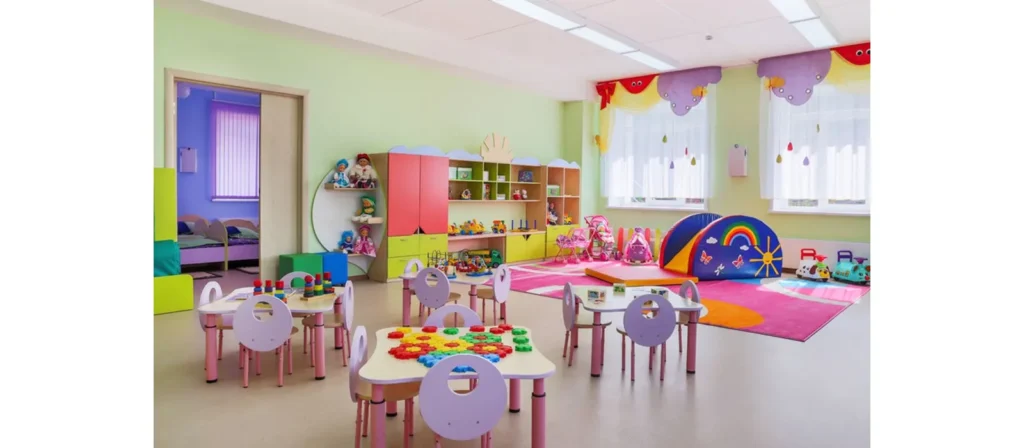
Die psychologischen Auswirkungen der Klassenzimmergestaltung
Research suggests that colors, spatial organization, and visual stimuli significantly impact children’s learning abilities and emotional well-being. Bright, warm colors can energize children, while soft pastels promote calmness and focus. Defined spaces within the classroom provide structure and help children transition smoothly between activities.
Förderung des Lernens durch visuelle Stimulation
Children in their early years learn best through sensory experiences. Thoughtfully designed preschool classroom decorations, including educational posters, themed displays, and hands-on interactive elements, help reinforce learning concepts and encourage exploration.
Förderung des sozialen und emotionalen Wachstums
A well-decorated classroom supports not just academics but also social and emotional development. Displays that celebrate student achievements, diversity, and teamwork foster a sense of pride and inclusivity among children.
15 Preschool Classroom Decoration Ideas
Below are the 15 core ideas with practical guidance. Some entries include short project plans, supply lists, or implementation steps. You don’t need to implement every idea at once; pick the ones that match your program’s goals, space, and children’s needs.
1. Create a Calming Environment
One of the first and most critical decorating decisions is setting the emotional tone of a classroom. Preschoolers thrive when the environment feels safe, predictable, and warm. Instead of overwhelming every wall with bold colors or every ceiling with dangling mobiles, aim for visual balance. Research indicates that classrooms with excessive visual stimulation can actually hinder attention and learning: in one study, children in heavily decorated rooms were off‑task significantly more than in sparsely decorated spaces.
- Choose a restrained palette. Pick two base tones and a bright accent used sparingly. For example: warm cream, sage green, and sunflower yellow accents. Use these across rugs, baskets, and bulletin borders.
- Designate quiet zones. Use a soft rug and low canopy to define a reading/calm area. Keep that area free from high‑contrast posters or flashing lights.
- Limit visual clutter. Opt for a few meaningful displays instead of covering every wall. Leave “negative space” — blank wall sections that reduce visual noise and let children rest their eyes.
- Lighting choices. Use diffused light — sheer curtains for windows and a soft lamp in the calm corner. Avoid direct harsh fluorescent lighting over the entire gathering area.
2. Decorate a Reading Area
A classroom without a dedicated reading space is like a library without shelves. Reading corners are not just functional—they’re emotional havens for preschoolers. A cozy, well-decorated reading area can promote literacy, build emotional security, and foster independent exploration.
Use soft seating like beanbags or small armchairs. Install low bookshelves so children can access books on their own. Then add thematic wall décor that matches current reading topics—jungle animals, fairy tales, outer space.
You can also include:
- Hanging mobiles with letters or characters
- Cushioned rugs with alphabet patterns
- Simple fabric canopies to create a “nook” feeling
If you have windows nearby, add light curtains to filter natural light and prevent distractions. The goal is to make this area inviting and slightly enclosed.
3. Decorate the Classroom with Kids’ Art
Displaying children’s creations increases motivation, builds identity, and makes the classroom feel like a shared community. It’s high‑impact, low‑cost décor that showcases learning processes, not just final products.
- Rotating gallery walls with framed student pieces
- A clothesline with clips to hang paintings
- Laminated drawings with each child’s name below
Make sure art is hung at the child’s eye level. You’re not just creating décor—you’re building self-esteem. It’s also a subtle classroom management tool. When children feel proud of their environment, they’re more likely to care for it.
4. Ideas for Bulletin Boards
Bulletin boards can be decorative, functional, and instructional all at once. They’re not just placeholders—they’re storytelling spaces. With thoughtful design, bulletin boards can support themes, showcase learning progress, and communicate important information.
- Monthly themes like seasons, community helpers, or holidays
- Student portfolios with writing samples or artwork
- Behavioral charts using positive reinforcement visuals
- Letter/Number of the week boards
Keep your boards interactive when possible. Add Velcro elements, flip panels, or spaces for student input. The more children can manipulate or engage with the board, the better.
Limit yourself to one or two major bulletin boards in the classroom, and keep the rest of the wall space calm and breathable.
5. Fun Birthday Displays
Celebrating birthdays in preschool is a great decorating opportunity. it builds community, acknowledges each child, and adds joy. But it’s important to balance fun with focus and inclusivity. But instead of generic, store-bought birthday posters, make your display personal and meaningful.
- A “birthday train” with each child’s photo in a train car
- A cupcake wall with children’s names and birthday dates
- A simple timeline with month headers and child-made icons
- Use a consistent format and color scheme to create continuity.
6. Design a Visual Schedule Board
Young children thrive on routine. When they can see what’s coming next, they feel more in control—and less anxious. A visual schedule board shows the daily routine in pictures and words. You can attach visuals with Velcro or magnets to move them around.
Images with short word labels are suitable for emerging readers and older children. Post the schedule near the door or gathering area for easy reference each morning. Choose a location near a transition (e.g., entryway, carpeted area) and at children’s eye level.
7. Decorate with a Welcome Banner
The first thing children see when they enter the classroom matters. A welcome banner can immediately establish a positive tone for the day.
Avoid overly flashy, generic “WELCOME!” signs. Instead:
- Use multi-language greetings to reflect classroom diversity
- Incorporate student photos or self-portraits
- Use themes like rainbows, trees, or sunshine to make it cheerful
You can involve children in making the banner. This increases their connection to the space and helps transition them into the learning environment from the very first step through the door.
8. Decorate the Classroom Door
The classroom door is an everyday canvas. Use it to reflect your classroom identity, themes, or even seasonal topics. With thoughtful decoration, it can become an extension of your classroom identity and a daily point of engagement.
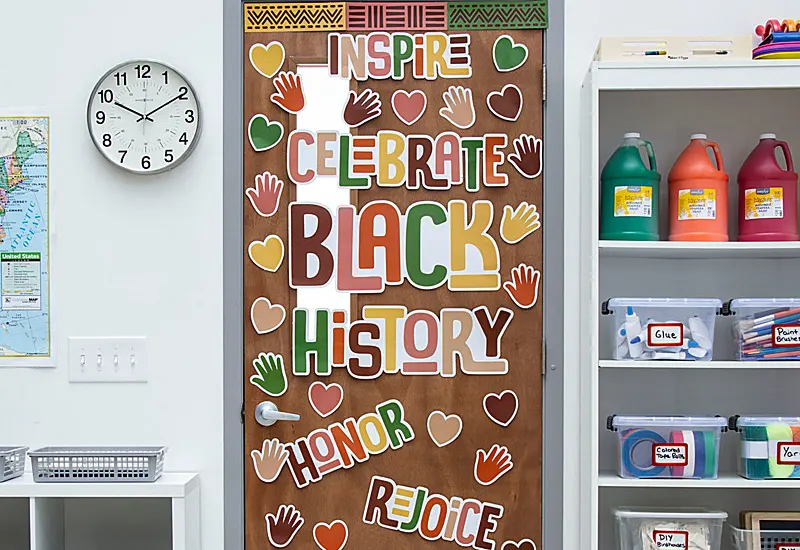
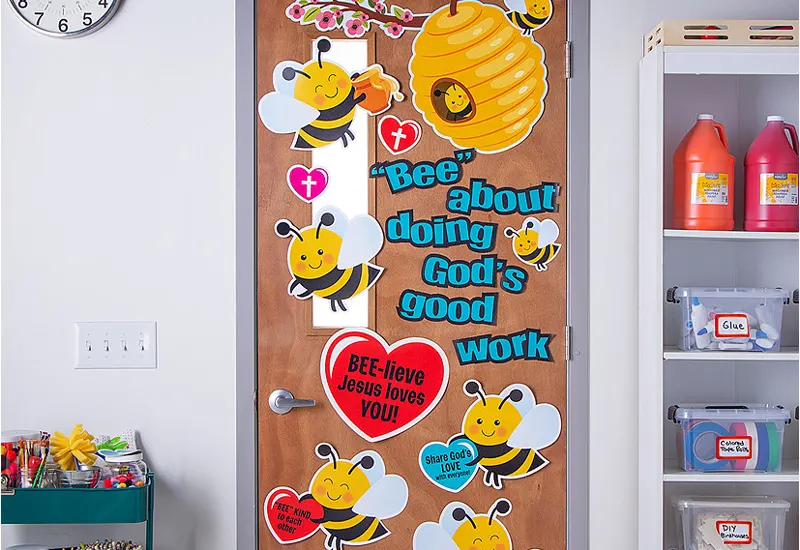
Ideas include:
- A “Who’s in Our Class?” door with children’s names and pictures
- A “Reading Adventure Starts Here” design for literacy-focused classrooms
- Seasonal or thematic displays like autumn leaves or space missions
9. Decorate the Windows and Ceiling
Many preschool teachers overlook the vertical space in the classroom. But the ceiling and windows are key visual elements in a child’s world. When decorated thoughtfully, they can bring warmth and depth to the classroom atmosphere.
Try these ideas:
- Paper lanterns or hanging pom-poms in thematic colors
- Mobiles representing seasons, numbers, or classroom mascots
- Window decals of animals, weather, or shapes
Be sure to balance visibility with safety. For windows, keep visibility clear at adult eye level but add designs at child height to make it engaging for them.
10. Use Rugs and Mats to Create Learning Areas
Floor decorations aren’t always visible. They’re also functional zones. Use rugs and mats to divide space and set behavioral expectations. Choose materials that are non-slip, easy to clean, and sized correctly for your classroom layout. Always opt for neutral or primary color schemes that match the overall classroom tone—not neon chaos.
11. DIY Wall Decor
DIY wall decorations are one of the most effective ways to bring personality and heart into your preschool classroom—without sacrificing budget or originality. Unlike store-bought posters that quickly become background noise, DIY décor invites participation, creativity, and connection.
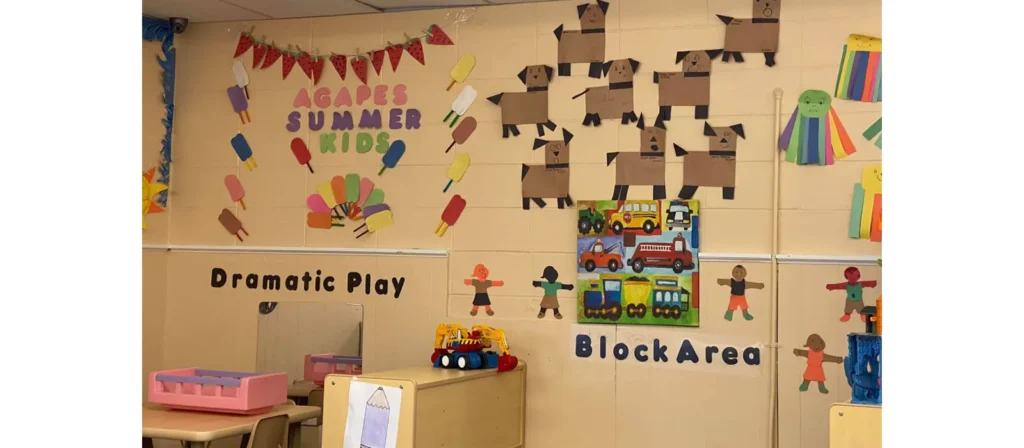
Here are DIY wall décor ideas:
- Create a “handprint tree” where each child adds their painted handprint as a leaf—then use it to track growth or seasons.
- Make a fabric or felt “learning journey” banner where children add personalized icons (e.g., “I learned to write my name,” “I counted to 20”).
- Use recycled magazine or paper scraps to create a colourful mosaic of shapes for a math wall.
- Use string and clothespins across a wall to display children’s current work.
- Have children help cut large letters or shapes for thematic walls and then allow them to place or arrange the pieces themselves.
- Laminate key visuals you use often so they last longer and can be reused year after year.
12. Creative Decorative Objects
While walls, boards, and rugs set the tone, the small decorative objects around your classroom are what give it warmth, depth, and storytelling. These elements should be intentional—not clutter—and always child-safe.
Classroom Mascots
Use a plush toy, puppet, or character figure as a “classroom mascot.” This character can sit on a shelf, participate in circle time, and even have its own name and backstory. It becomes a beloved member of the group and offers continuity.
Thematic Tabletop Displays
Create small decorative setups for the season or unit theme. For example:
- A basket of fall leaves, pinecones, and tiny pumpkins
- A globe, astronaut doll, and stars for space week
- Dinosaurs and faux fossils during a prehistoric unit
Keep these displays simple and child-accessible, using them to spark curiosity and discussion.
Repurposed Natural Materials
Use wooden bowls, stones, shells, or driftwood as both décor and manipulatives. They add texture and a sensory element to the environment, aligning well with Reggio and Montessori principles.
Family Photo Walls or Frames
A small corner with framed family photos helps create emotional security and connection. Each child can bring a family photo to display. This humanizes the room and helps children feel grounded.
Don’t overdo it—just a few key messages placed meaningfully can have a big impact.
13. Name Tags and Personalized Spaces
Personalization in the classroom helps each child feel valued and visible. At this developmental stage, children are forming a sense of identity, and seeing their name and picture on their cubby, seat, or project folder affirms their belonging in the classroom.
Name tags should be simple, clear, and easy to recognize. Ideally, they include the child’s name in large print alongside a visual cue, like a photo or a symbol. This helps children who are still developing literacy skills quickly locate their belongings. Teachers can even involve students in designing their own labels, giving them a sense of ownership and a creative opportunity to express themselves.
These personalized elements can extend beyond cubbies and tables. Mailboxes, supply bins, art drying racks, and classroom job charts can all be labeled with children’s names.
14. Music and Sound as Part of the Decor
While not visual, acoustic decorations can deeply influence the classroom atmosphere. Incorporating soft music, sound centers, or even musical instrument walls can enhance mood and support auditory learning.
Design ideas:
- A hanging bell wall where children can gently ring chimes
- A music corner with soft drums, maracas, or xylophones
- Background classical or nature soundtracks played during quiet time
Sound should be soothing, not overstimulating. Just like color and light, sound is an environmental tool that shapes behavior.
15. Reuse and Use Old Materials for Decorating
One of the most practical, sustainable, and creative decorating strategies is repurposing and reusing materials. This fosters resourcefulness, reduces cost, and often generates richer student‑centered décor.
Preschool decorating doesn’t need to strain your budget. Some of the most creative classroom spaces I’ve seen used entirely upcycled and repurposed materials.
- Turning old T-shirts into wall banners
- Using scrap fabric to create hanging flags
- Repurposing cardboard into student art canvases
- Framing sections of newspaper or old picture books
Überlegungen zur Dekoration des Vorschulklassenzimmers
Decorating a preschool classroom may seem like a simple task, but in reality, it requires thoughtful consideration, strategic planning, and a strong understanding of child development. An effective preschool classroom should be colorful and cheerful, yes—but also functional, safe, and developmentally appropriate. Every visual element you introduce into the space should serve a purpose: to support learning, reinforce routines, build a sense of community, or encourage independence.

1. Use Bright Colors
Bright colors capture attention and create excitement. Young children are naturally drawn to vivid hues, and the right color palette can stimulate learning, reinforce themes, and differentiate classroom zones. However, the use of color should be intentional. Too much brightness everywhere can cause visual clutter and overstimulation.
2. Keep It at Eye Level
Since preschoolers spend most of their day sitting, playing, and walking close to the floor, decorations should be placed at their eye level. This helps children engage more meaningfully with visual aids, thematic displays, and instructional signage. It also fosters independence.
3. Keep Children Involved
When children help create or choose classroom decorations, they feel a sense of ownership and belonging. It fosters confidence and builds classroom community. Their contributions also reflect real learning and personal expression, making the décor more meaningful than store-bought posters.
4. Stay Organized
Young children rely heavily on structure. When decorations are messy or overdone, they blur those boundaries and confuse behavioral cues. Keeping things orderly doesn’t mean dull. It means that every visual element has a purpose, and everything has a place. Organized décor supports calmness, reduces conflict, and builds a productive learning environment where children feel secure.
5. Use Safe Materials
Safety should never be compromised in favor of aesthetics. All décor must be made from non-toxic, age-appropriate, and durable materials. Safety concerns include choking hazards, sharp edges, or flammable items. Ensuring all materials meet health and safety standards protects both children and staff, reducing risk during daily activities.
6. Keep Safety in Mind
Beyond material safety, decoration placement affects visibility, traffic flow, and emergency access. Hanging décor must be secure, exits must remain clear, and walkways must be free of tripping hazards. Designing with safety in mind prevents accidents and supports smooth classroom operations.
7. Choose the Right Furniture
Classroom decoration doesn’t start with posters and streamers—it starts with furniture. The layout, color, height, and placement of your tables, chairs, cubbies, and shelving units all play a role in how the classroom feels and functions.



- Select age‑appropriate furniture: Child‑sized tables, chairs, shelves at reachable heights.
- Consider flexible furniture: Pieces that can move easily or reconfigure support dynamic décor zones and seasonal changes.
- Furniture should serve dual purposes: For example, bookcases that display books cover‑out, or low cabinets with decorative tops to define zones and display children’s work.
- Matches the decor: Consistent finishes, clean lines, minimal patterns help décor and furniture feel unified.
- Durability and maintenance: Furniture for preschoolers must withstand active use, spills, and be easy to clean and rearrange.
Senden Sie uns eine Nachricht, wenn Sie Fragen haben oder ein Angebot anfordern möchten. Unsere Experten antworten Ihnen innerhalb von 48 Stunden und helfen Ihnen bei der Auswahl des richtigen Produkts.
8. Remember to Change Your Decor
Children thrive on novelty and seasonal rhythms. Updating classroom decorations throughout the year keeps the environment stimulating and relevant. Whether it’s monthly bulletin boards, seasonal themes, or rotating student artwork, a changing environment supports curiosity and engagement. It also reinforces concepts like time, transitions, and cycles. However, changes should be predictable and structured—not random. A consistent update schedule helps children anticipate change and adjust comfortably. Planning décor updates alongside curriculum themes is the most effective approach.
9. Control Your Budget
A well-decorated classroom doesn’t have to break the bank. Reusing materials, incorporating student artwork, and DIY projects can achieve meaningful, personalized décor without excessive spending. Budget-friendly choices also model sustainability and creative problem-solving for children.
How to Decorate Spaces with Different Functions?
Ein gut organisiertes Klassenzimmer sollte klar abgegrenzte Bereiche für verschiedene Aktivitäten haben. Diese Bereiche helfen den Kindern zu verstehen, wo bestimmte Aufgaben stattfinden, und sorgen für reibungslosere Übergänge im Tagesverlauf.
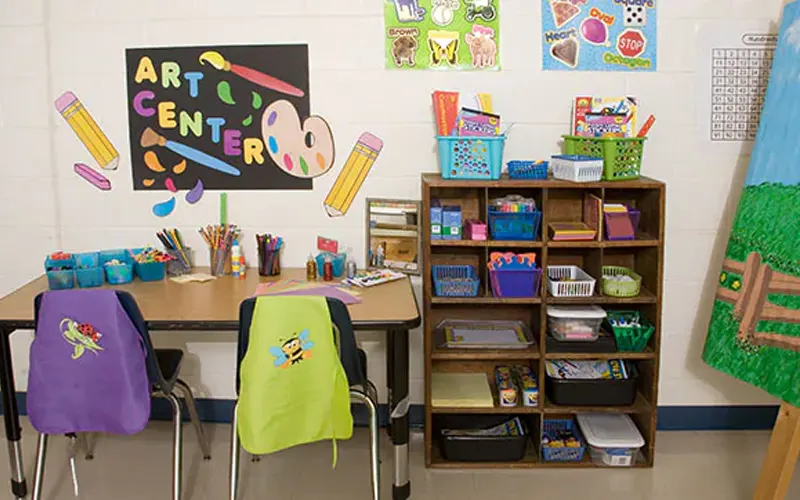
Vorschulisches Kunstzentrum
Ein Kunstzentrum ist ein Muss für die Förderung von Kreativität und Selbstentfaltung. Bestücken Sie ihn mit kinderfreundlichen Materialien wie Buntstiften, Farbe und recyceltem Bastelmaterial. Nutzen Sie farbenfrohe Wanddisplays und Trockenständer, um die Kunstwerke der Schüler zu präsentieren und den Raum inspirierend und funktional zugleich zu gestalten.
Wissenschaftszentrum für Vorschulkinder
Ein praktisches Wissenschaftszentrum Weckt Neugier und Entdeckergeist. Statten Sie den Bereich mit Lupen, Sensorikbehältern und einfachen Experimenten aus. Poster mit Natur-, Planeten- und Körpermotiven können als ansprechende Dekoration im Vorschulklassenzimmer dienen und junge Köpfe zum Fragen und Entdecken anregen.
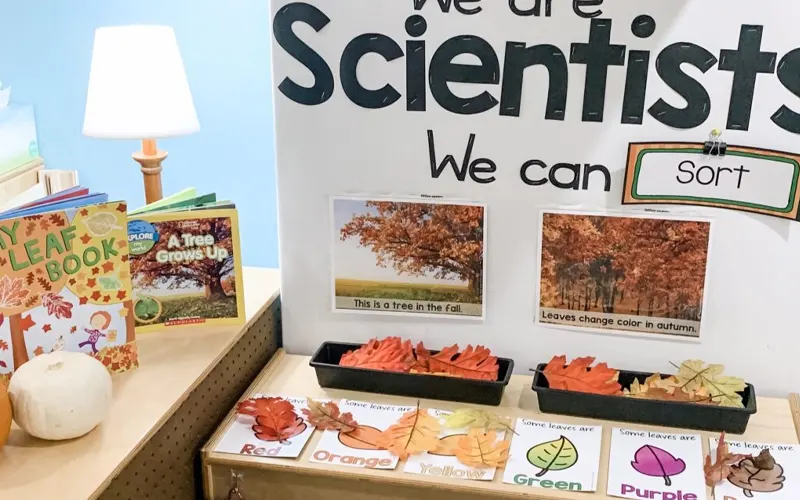
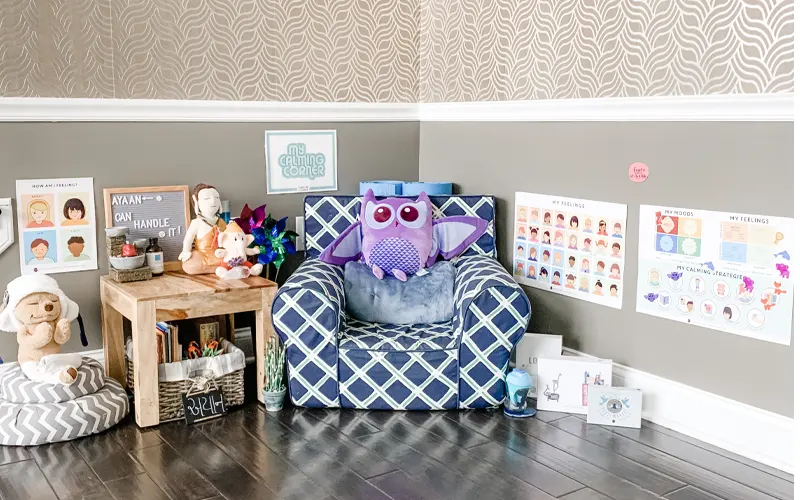
Ruheecke
A Ruheecke Hilft Kindern, sich selbst zu regulieren und mit Emotionen umzugehen. Verwenden Sie weiche Sitzgelegenheiten, gedeckte Farben und sensorische Elemente wie Zappelspielzeug oder Gewichtsdecken. Naturbezogene Dekorationen wie ein Sternenhimmel oder sanfte Beleuchtung können den Raum noch beruhigender gestalten.
Leseecke im Klassenzimmer
Eine gemütliche Leseecke Fördert die Liebe zu Büchern. Gestalten Sie Regale mit griffbereiten Bilderbüchern, stellen Sie Sitzsäcke oder Kissen für mehr Komfort bereit und dekorieren Sie mit Alphabet-Postern oder Wandaufklebern mit Geschichtenmotiven, um einen einladenden literarischen Raum zu schaffen.
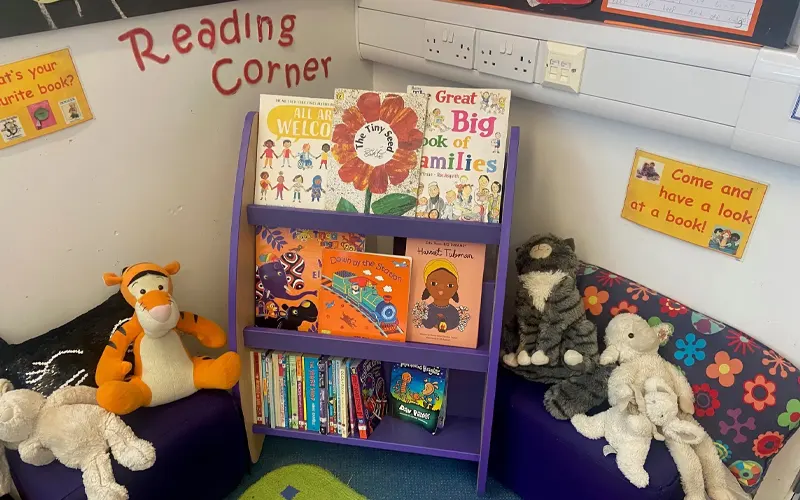
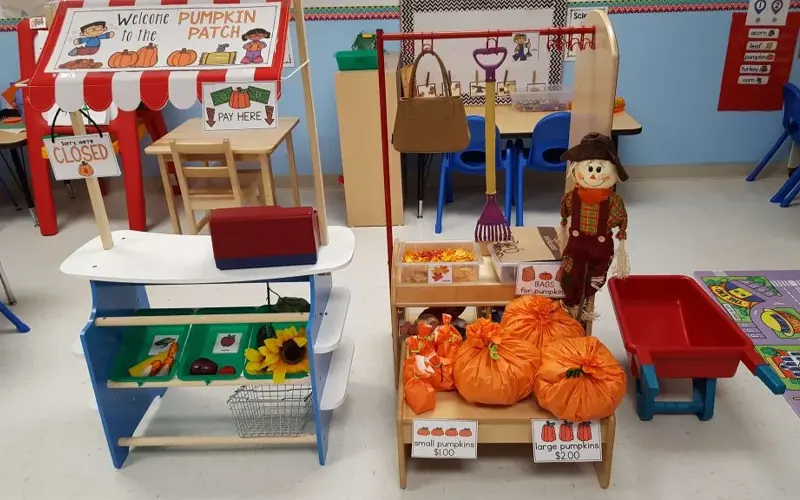
Rollenspielbereich
Dramatisches Spiel fördert soziale und kognitive Fähigkeiten. Ob Spielküche, Minimarkt oder Arztpraxis – Requisiten und thematische Hintergründe regen fantasievolles Spielen an. Wechseln Sie die Aufbauten regelmäßig, damit der Raum für Kinder spannend bleibt.
Saisonale Dekorationen für Vorschulklassen
Die Dekoration eines Vorschulklassenzimmers entsprechend der Jahreszeiten sorgt für eine frische, ansprechende und lehrreiche Atmosphäre. Saisonale Themen helfen Kindern, sich mit der Natur zu verbinden, Veränderungen in der Welt um sie herum zu entdecken und besondere Anlässe zu feiern. Ob leuchtende Blumen im Frühling oder kuschelige Schneeflocken im Winter – saisonale Dekorationen im Vorschulklassenzimmer verbessern die Lernatmosphäre und machen das Klassenzimmer zu einem spannenden Ort für junge Lernende.
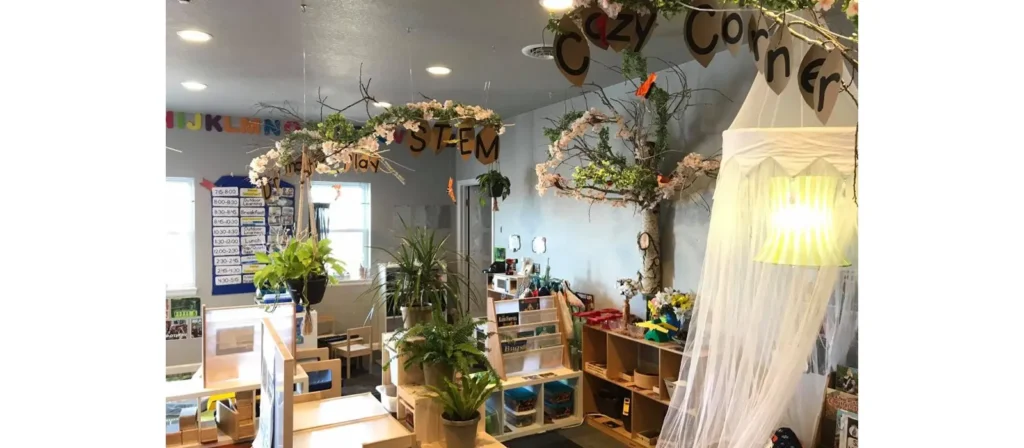
Frühlingsdekorationen für das Vorschulklassenzimmer
Der Frühling ist die Jahreszeit der Erneuerung und damit die perfekte Zeit, um frische, farbenfrohe und von der Natur inspirierte Dekorationsthemen für Vorschulklassenzimmer einzubringen.
- Wanddekorationen: Um eine lebendige Atmosphäre zu schaffen, verwenden Sie Wanddekorationen für Vorschulklassenzimmer wie Schmetterlingsausschnitte, Blumengirlanden und Regenbogenbanner.
- Türdekorationen für Klassenzimmer: Überlegen Sie sich Ideen für die Dekoration der Klassenzimmertür im Vorschulalter, beispielsweise eine Tür mit dem Motiv „Growing Garden“ mit Papierblumen und den Namen der Schüler als Blütenblätter.
- Deckendekorationen: Hängende Dekorationen wie Papierwolken, Regentropfen und Sonnenschein können dem Raum eine leichte und luftige Atmosphäre verleihen.
- Aktivitätsecken: Erstellen Sie eine Pflanzstation, an der Kinder kleine Pflanzen oder Kräuter züchten können, und integrieren Sie dabei Dekorationsideen für das Klassenzimmer im Vorschulalter mit Gartenthemen.
- Druckbare Dekorationen: Verwenden Sie druckbare Materialien zur Dekoration von Vorschulklassenzimmern, wie etwa Alphabetposter mit Frühlingsmotiven und naturbasierte Lerntafeln.
Sommerliche Vorschulklassenzimmerdekorationen
Die Dekoration des Sommerklassenzimmers sollte Wärme, Abenteuer und Spaß im Freien widerspiegeln. Dekorationsideen für die Vorschule im Sommer beinhalten oft Strand-, Meeres- und Campingthemen.
- Wanddekoration: Präsentieren Sie Meereswellen, Fische und Muscheln mit Wanddekorationen für den Vorschulunterricht, um eine Unterwasserwelt zu schaffen.
- Themenorientierte Klassenzimmerdekoration: Verwenden Thema für das Vorschulklassenzimmer Dekoration mit Wasserbällen, Sandburgen und Sonnenbrillen für eine verspielte Atmosphäre.
- Klassenzimmerfenster: Fügen Sie bunte Sonnenaufkleber oder Handabdruckkunst hinzu, um die Fensterdekoration im Vorschulklassenzimmer aufzupeppen.
- DIY-Dekor: Integrieren Sie eine DIY-Dekoration für Ihr Vorschulklassenzimmer, indem Sie Fächer, Drachen und Windräder aus Papier basteln.
Herbstliche Vorschulklassenzimmerdekorationen
Herbstdekorationen bringen warme Töne, Erntethemen und saisonale Feste. Herbstdekorationen für Vorschulklassen konzentrieren sich oft auf Kürbisse, Blätter und Waldtiere.
- Wand- und Pinnwände: Nutzen Sie Ideen zur Wanddekoration im Klassenzimmer für den Vorschulbereich mit fallenden Blättern, Vogelscheuchen und gemütlichen Herbstszenen.
- Klassenzimmertüren: Werden Sie kreativ mit Ideen für die herbstliche Dekoration der Klassenzimmertür im Vorschulalter, beispielsweise einem „Kürbisbeet“ mit dem Namen jedes Schülers auf einem Kürbis.
- Hängende Dekoration: Die Deckendekoration im Vorschulklassenzimmer kann aus Herbstblättern, Eicheln und Eulen bestehen.
- Interaktive Elemente: Ein Dankbarkeitsbaum, an dem Kinder Dankesbriefe hinterlassen, ist eine tolle Dekorationsidee für das Vorschulklassenzimmer.
Winterliche Vorschulklassenzimmerdekorationen
Winterthemen schaffen mit Schneeflocken, Fäustlingen und festlicher Dekoration eine gemütliche und zauberhafte Lernumgebung. Winterdekorationen für den Vorschulunterricht sorgen für Spannung, da Kinder etwas über Winterwetter und Feiertage lernen.
- Wand- & Fensterdekorationen: Verwenden Sie Winterdekorationen für Vorschulklassen wie Schneeflockenausschnitte, Eiszapfengirlanden und Wintertiere.
- Klassenzimmertüren: Zu den Ideen für die winterliche Türdekoration im Vorschulklassenzimmer gehört ein „Winterwunderland“-Thema mit Schneemännern und einer Rodelszene.
- Deckendekor: Hängen Sie Baumwollschneeflocken oder sanfte Lichter auf, um eine festliche Atmosphäre zu schaffen.
- Sensorische Bereiche: Ein sensorischer Behälter mit Schneemotiv, Kunstschnee und winterlichen Tierfiguren bereichert die Dekorationsthemen für das Klassenzimmer im Vorschulalter.
Weihnachtsdekorationen für das Vorschulklassenzimmer
Weihnachtsdekorationen machen Vorschulklassenzimmer festlich und aufregend. Ob Halloween, Thanksgiving oder Weihnachten – Dekorationen im Vorschulklassenzimmer helfen Kindern, kulturelle Traditionen zu verstehen und verleihen dem Raum Wärme und Spaß.
Halloween-Dekorationen für das Vorschulklassenzimmer
Halloween-Dekorationen bringen spielerische Gruselstimmung ins Klassenzimmer. Die Halloween-Dekoration im Vorschulklassenzimmer sollte Spaß machen und nicht zu gruselig sein.

- Wanddekorationen: Verwenden Sie Klassenzimmerdekorationen für den Vorschulbereich, wie freundliche Geister, Kürbisse und Fledermäuse.
- Klassenzimmertüren: Ideen für die Türdekoration im Vorschulklassenzimmer können ein „Freundliches Monster“- oder „Kürbisbeet“-Thema beinhalten.
- Interaktives Dekor: Eine „Süßes oder Saures“-Zähltafel kann Teil der Dekoration im Vorschulklassenzimmer sein und gleichzeitig das Lernen fördern.
- DIY-Handwerk: Ermutigen Sie die Kinder, Kürbislaternen und Spinnennetze aus Papier zu basteln, um das Klassenzimmer zu dekorieren.
Thanksgiving-Dekorationen für das Vorschulklassenzimmer
Die Thanksgiving-Dekoration konzentriert sich auf Dankbarkeit, Ernte und Zusammengehörigkeit. Die Dekoration des Klassenzimmers im Kindergarten für Thanksgiving kann warme Herbsttöne und thematische Elemente umfassen.

- Wand- und Pinnwände: Ein „Dankbarkeitsbaum“ mit von Schülern gestalteten Blättern, die Dankbarkeit ausdrücken, ist eine ansprechende Wanddekoration für das Vorschulklassenzimmer.
- Türdekorationen für Klassenzimmer: Türdekorationen für Vorschulklassenzimmer, beispielsweise ein Truthahn mit den Handabdrücken der Schüler als Federn, verleihen eine persönliche Note.
- Tischdekorationen: Verwenden Sie Dekorationselemente für den Vorschulunterricht, wie etwa Papierkürbisse, Füllhörner und Herbstgirlanden.
Weihnachtsdekorationen für das Vorschulklassenzimmer
Weihnachtsdekorationen bringen Freude und Wärme in die Vorschulumgebung. Weihnachtsdekorationen im Vorschulklassenzimmer können festliche Farben, festliche Figuren und gemütliche Winterthemen aufweisen.
Druckbares Dekor: Ausdruckbare Dekorationen für Vorschulklassenzimmer, wie etwa feiertagsbezogene Alphabettafeln und Zahlenposter, verleihen dem Lernen eine festliche Note.
Wand- und Deckendekoration: Verwenden Sie im Vorschulunterricht Weihnachtsdekorationen wie Schneeflocken, Weihnachtsbäume und funkelnde Lichter.
Klassenzimmertüren: Zu den Dekorationsideen für die Tür von Vorschulklassenzimmern gehören Themen wie „Weihnachtsmannwerkstatt“ oder „Lebkuchenhaus“.
Weihnachtsbastelecke: Zu den Ideen für die Weihnachtsdekoration im Vorschulklassenzimmer kann eine Station zum Selbermachen von Weihnachtsschmuck gehören.
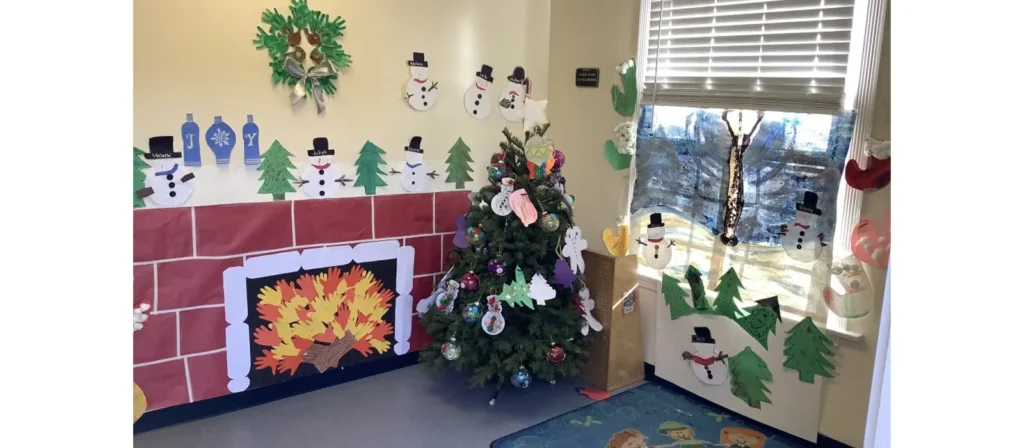
Abschluss
Die Dekoration von Vorschulklassenzimmern spielt eine entscheidende Rolle für das Lernerlebnis kleiner Kinder. Ein gut dekoriertes Klassenzimmer bietet visuelle Anregungen, fördert die Interaktion und fördert die Kreativität. Durch die sorgfältige Auswahl von Themen, den Einsatz interaktiver Elemente und die Einbeziehung saisonaler und festlicher Dekorationen können Pädagogen eine dynamische und ansprechende Lernumgebung schaffen.
Von interaktiven Pinnwänden bis hin zu naturinspirierten Dekorationen – jedes Element im Klassenzimmer sollte das Lernen unterstützen und gleichzeitig den Raum einladend und angenehm gestalten. Die Dekoration sollte sowohl funktional als auch unterhaltsam sein und dafür sorgen, dass sich Kinder jeden Tag inspiriert fühlen, wenn sie ihr Vorschulklassenzimmer betreten.
Durch die kontinuierliche Aktualisierung der Umgebung können Lehrer das Engagement und die Begeisterung der Schüler für das Lernen aufrechterhalten und so eine Grundlage für lebenslange Neugier und Kreativität schaffen.




